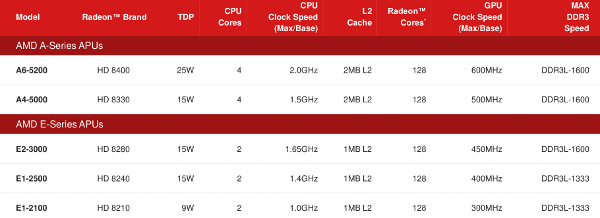 Kabini is finally here with two different chip names and eight SKUs, all from one hunk of silicon. If you want to know the specs of Kabini and Temash, you have clicked on the right link.
Kabini is finally here with two different chip names and eight SKUs, all from one hunk of silicon. If you want to know the specs of Kabini and Temash, you have clicked on the right link.
Kabini and Temash are the same die, no differences other than what fuses are blown. Both come in two and four core versions and range from 1.0-2.0GHz while consuming between 3.9 and 25W. Temash is on the lower end of this range so it caps out at 9W, Kabini picks up from there and goes to the 25W max. All variants have 128 Sea Islands/HD8000 GPU cores at speeds all over the map. It all looks like this.
The three flavors of Temash
Add two more and you get five Kabinis
The stats are pretty self-explanatory with a few points to call out here and there. First is that two core models have 1MB of L2 and four cores have 2MB. This means each of the four cache tiles are directly tied to their respective core. Although all four are usable by any core when on, fusing off a core looks to take the associated 512K tile with it. We went in to detail about the cache architecture and the rest of the Jaguar core here if you want more details about how this all works.
Next up is memory and Kabini supports DDR3L at 1333MHz and 1600MHz, Temash uses 1066MHz and 1333MHz, all are one 64-bit channel wide. DDR3L is the new brand name for 1.25V DDR3, it draws roughly 70% of the wattage that a 1.5V DDR3 stick at the same speed pulls. For a mobile platform, supporting this is a no-brainer. In any case, 1333MHz memory on a 9W part should yield some very impressive battery life numbers.
One curious stat is that only the A6-1450, the highest Temash SKU, has a base/max clock speed. The reason for this is something called Turbo Dock, a fancy way of saying they crank the power way up when it is plugged in to the wall. When you dock a tablet or Temash WIAFFNOWBMAIWTHACTSTBITPCM (Widget In A Form Factor No One Wants But Microsoft And Intel Wrongly Think Has A Chance To Stop The Bleeding In The PC Market), can pull up to 2x the power if cooling permits. This gives up to a 40% clock speed increase and refreshingly AMD only claims a 30%+ performance boost. This harkens back to the old days of battery vs wall mode on laptops, but it is still a worthwhile idea today.
All is not rosy in Kabini-land though and as is usually the case, the problems come from the marketing end. Traditionally at AMD the big cores get the Ax name and the small cores are prefixed with Ex so you can tell what chip is in a device just by looking at the label. Now look at the Kabini names again. Notice some are Ax and some are Ex, all of the Temash parts are now Ax too? Can you say needless customer confusion? Can you say noxious? Shall I go on? With this one brilliant stroke, AMD has taken a great part and rendered it annoying to even think about. Pity.S|A
Charlie Demerjian
Latest posts by Charlie Demerjian (see all)
- Qualcomm Is Cheating On Their Snapdragon X Elite/Pro Benchmarks - Apr 24, 2024
- What is Qualcomm’s Purwa/X Pro SoC? - Apr 19, 2024
- Intel Announces their NXE: 5000 High NA EUV Tool - Apr 18, 2024
- AMD outs MI300 plans… sort of - Apr 11, 2024
- Qualcomm is planning a lot of Nuvia/X-Elite announcements - Mar 25, 2024

